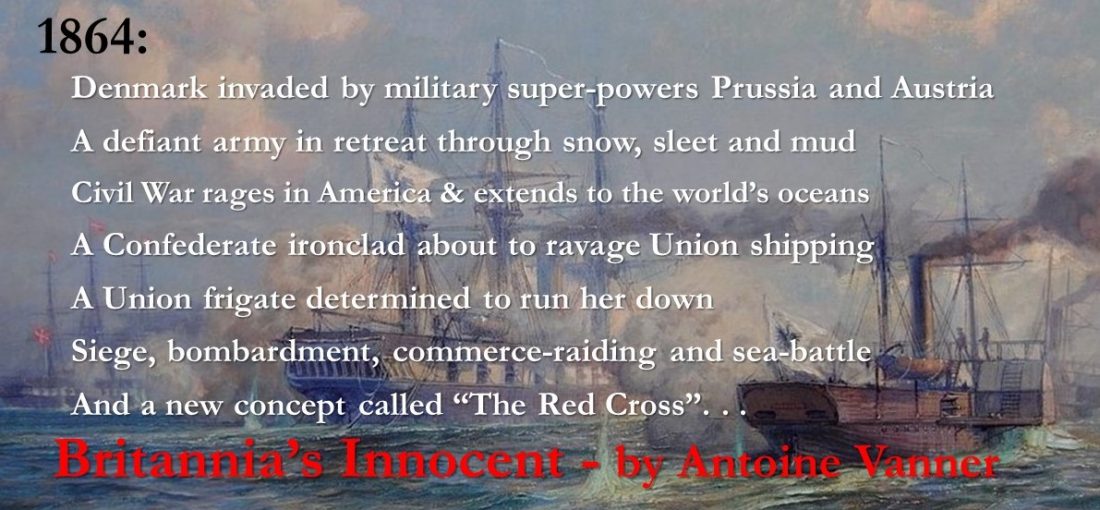The Battle of Coronel, November 1st 1914 – Part 1
The Battle of Coronel, the first defeat to be suffered at sea by Britain’s Royal Navy in a century, was fought in stormy seas and fading light off the coast of Chile and was to result in the loss of over 1600 men. The circumstances were dramatic – and tragic – in the extreme.
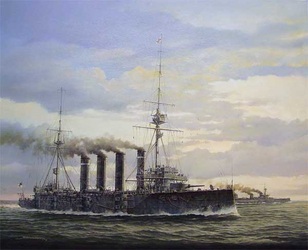
The tragic HMS Good Hope (Attribution unknown – found on Pinterest)
Imperial German Navy ships stationed outside home waters at the outbreak of WW1 were in an unenviable position. German possessed only one fortified naval base overseas – at Tsingtao in China. The various German colonies around the world – Togo, Cameroon, South-West Africa, Tanganyika, Northern New Guinea and various Pacific island groups, could provide only limited coaling and maintenance facilities. Tanganyika held out – in a brilliantly conducted land campaign – until the end of the war but all other colonies were conquered by Britain and her allies in the opening months. As her coast was blockaded from the beginning, Tanganyika could provide no facilities to support naval operations.
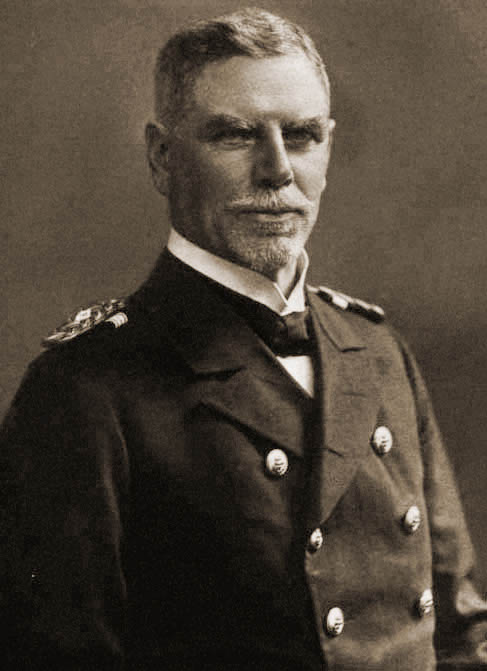
von Spee
Germany’s main overseas naval force was the East Asia Squadron, based in Tsingtao. Commanded in 1914 by Vice Admiral Maximilian, Reichsgraf von Spee, its main strength lay in two modern armoured Cruisers, the Scharnhorst and Gneisenau, and four modern light cruisers, Dresden, Emden, Leipzig and Nürnberg. There were a number of gunboats and a single destroyer, mainly for policing-type actions along the coast of China. Impressive as this force might seem, it was puny by comparison with the naval forces of Britain’s ally, Japan, which not only deployed large numbers of superb ships and manned them with seasoned professionals, but which nine years before had achieved the greatest naval victory in history up to that time. There were in addition British ships in the area, and the Royal Australian Navy’s flagship, the battlecruiser HMAS Australia, was alone superior to von Spee’s entire squadron.
When war broke out in August 1914 most of the warships of the East Asia Station were dispersed at various island colonies on routine missions. Von Spee recognised that Tsingtao could not be held indefinitely – the Japanese declared war on German in August 23rd, after which they joined Britain in a blockade and siege of the base. Von Spee accordingly ordered his ocean-going vessels to rendezvous at Pagan Island in the northern Marianas.
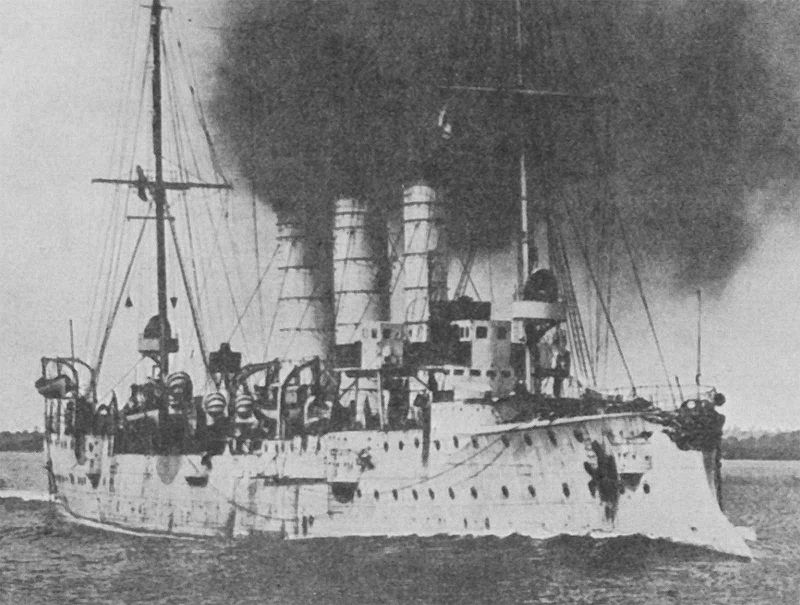
SMS Leipzig – other German light cruisers essentially similar
In conference with his commanders at Pagan, von Spee planned, probably with little expectation of success, a return across the world to Germany. The key factor would be coal supply by chartered colliers, which would have to meet the squadron at various points, their movements being coordinated by radio. Organising this, and making it happen operationally in the teeth of massive sweeps by the British and Japanese, was likely to be difficult in the extreme. The Emden was detached to conduct a separate – and very successful – campaign in the Indian Ocean (Click here to read an article about this). Von Spee was starved of news as all German undersea cables through British controlled areas had been cut, and radio capabilities were still very limited. The Nürnberg was therefore dispatched to Hawaii – neutral territory – to gather war news. Von Spee headed for German Samoa with Scharnhorst and Gneisenau, then east, towards the French possession of Tahiti, where they made a brief bombardment. Reunited, the squadron coaled at Easter Island from German colliers.
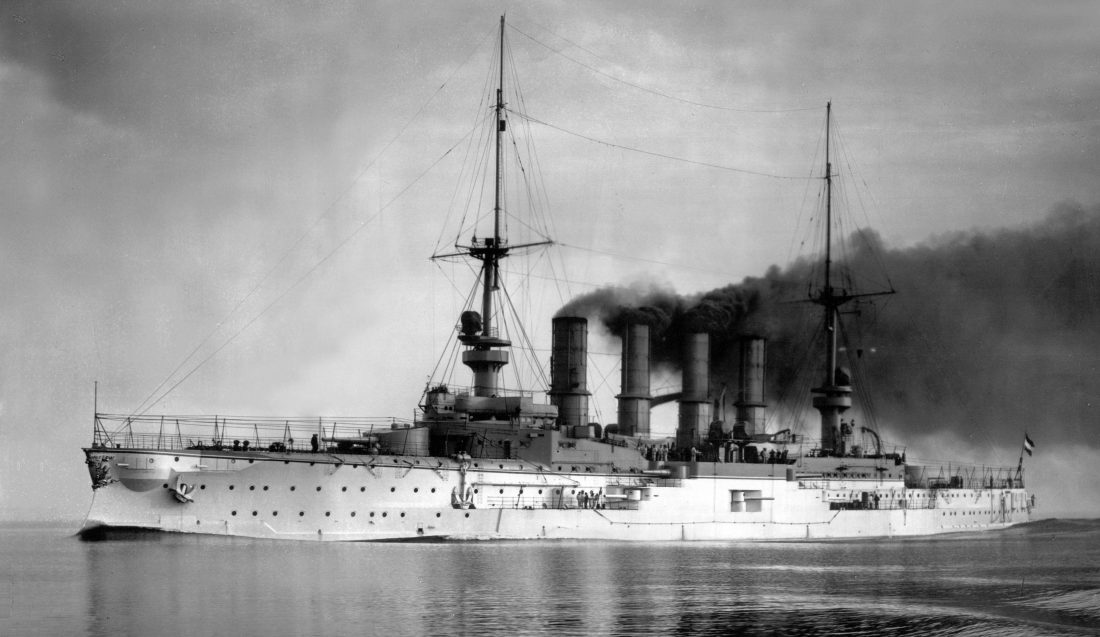 SMS Gneisenau, identical to her sister Scharnhorst, in pre-war ochre and white livery
SMS Gneisenau, identical to her sister Scharnhorst, in pre-war ochre and white livery
An obsolete cruiser SMS Geier, failed to make the rendezvous at Pagan, and had to intern herself at then-neutral Hawaii because of technical problems (Click here to read an article about her). Left behind at Tsingtao were four small gunboats Iltis, Jaguar, Tiger, Luchs and the torpedo boat S-90. This latter craft was to score a significant success by torpedoing and sinking the old Japanese cruiser Takachiho on October 29th. All these craft were scuttled prior to surrender of Tsingtao to the British and Japanese in November.
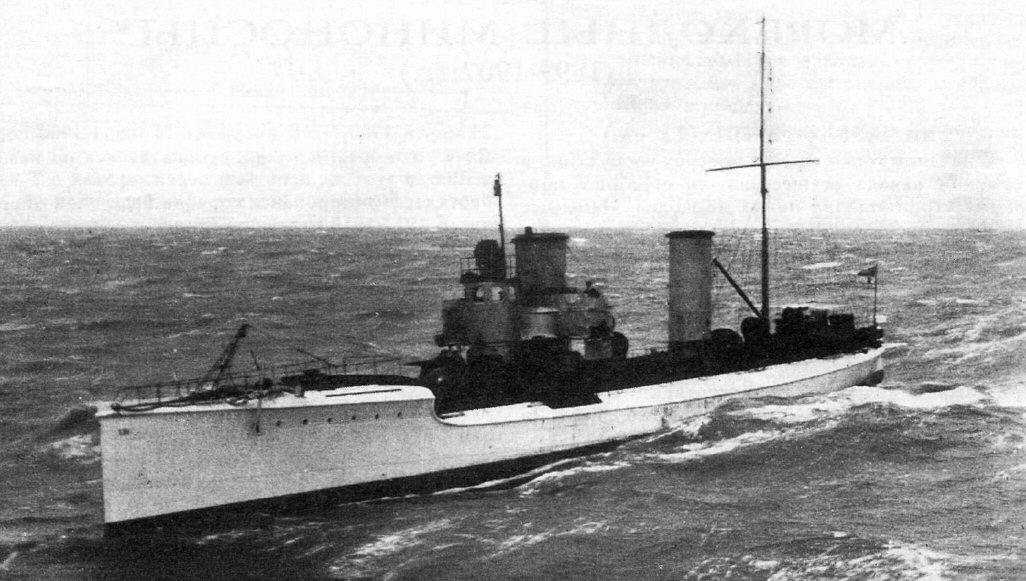 SMS S-90, Nemesis of the old Japanese cruiser Takachiho
SMS S-90, Nemesis of the old Japanese cruiser Takachiho
The British Admiralty made destruction of von Spee’s squadron a high priority. The futile German bombardment of Papeete, Tahiti, and the destruction of an old French gunboat there (wasting ill-afforded ammunition in the process) led the British to concentrate the search in the Western Pacific. This seems very unwise in retrospect since Japan, Britain’s ally, already had substantial forces in this area. It was only in early October that an intercepted radio message indicated that von Spee was heading for the west coast of South America to destroy British merchant shipping there.
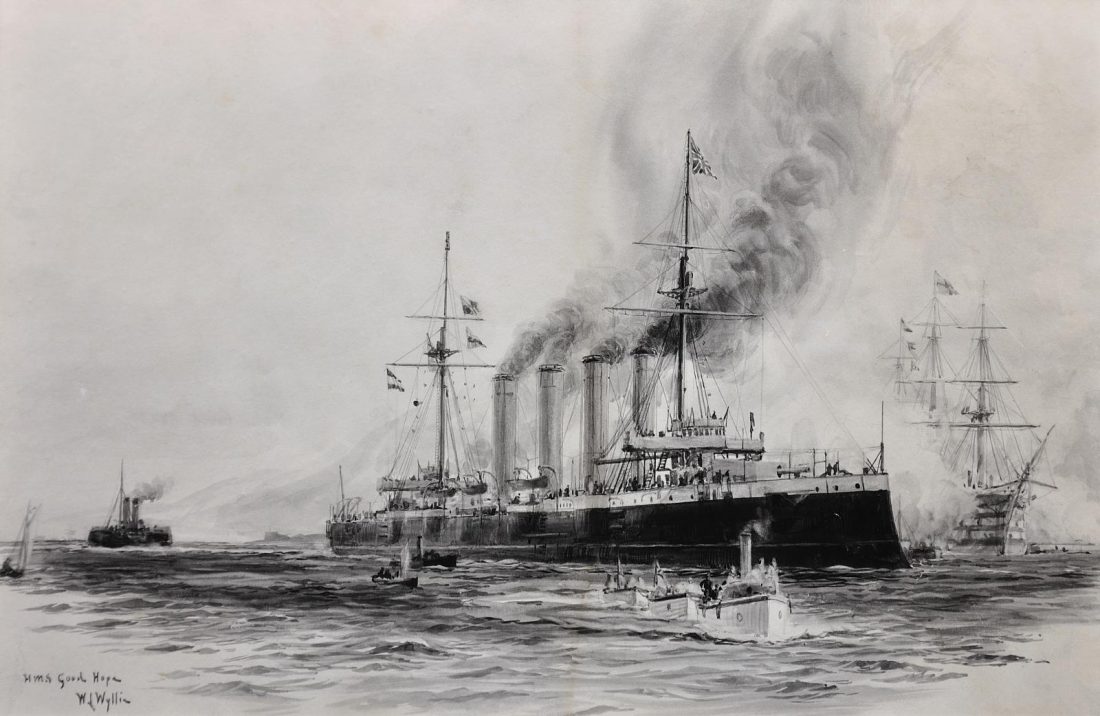 Good Hope, soon after commissioning
Good Hope, soon after commissioning
Drawing by the eminent marine artist William Lionel Wyllie
The British squadron sent into the Pacific from the South Atlantic to counter such a move was almost wholly made up of obsolescent or poorly-armed vessels, crewed by naval reservists called back to service without time for refresher training. The force commanded by Rear-Admiral Sir Christopher Cradock consisted of the near-obsolete armoured cruisers HMS Good Hope (flagship), and HMS Monmouth, the modern light cruiser HMS Glasgow and a weakly-armed converted liner, the HMS Otranto. For heavy backup Cradock was assigned the slow, but powerfully-armed, pre-dreadnought HMS Canopus. In the event, the latter’s worn-out machinery made it impossible, despite heroic efforts by her engine-room crew, to keep pace with the cruisers.
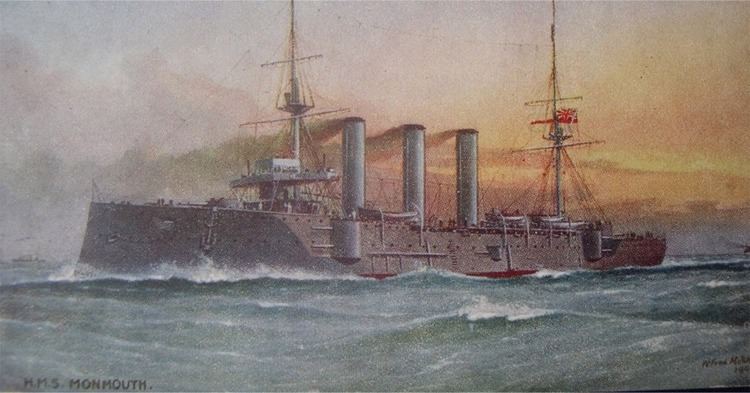 HMS Monmouth
HMS Monmouth
Except for two individual 9.2-inch turret-mounted guns on HMS Good Hope, and four 6-inch similarly mounted on HMS Monmouth, the remaining twenty-six 6-inch weapons carried by the armoured cruisers were positioned in casemates built into the sides of the hulls. Some of these casemates were “two-storey” ones, with the lower positions inoperable in any significant seaway. This made a substantial portion of the armament essentially unusable and, as the weakness was so obvious – and must have been noticed during exercises – one wonders why naval architects persisted with this feature through successive design classes.
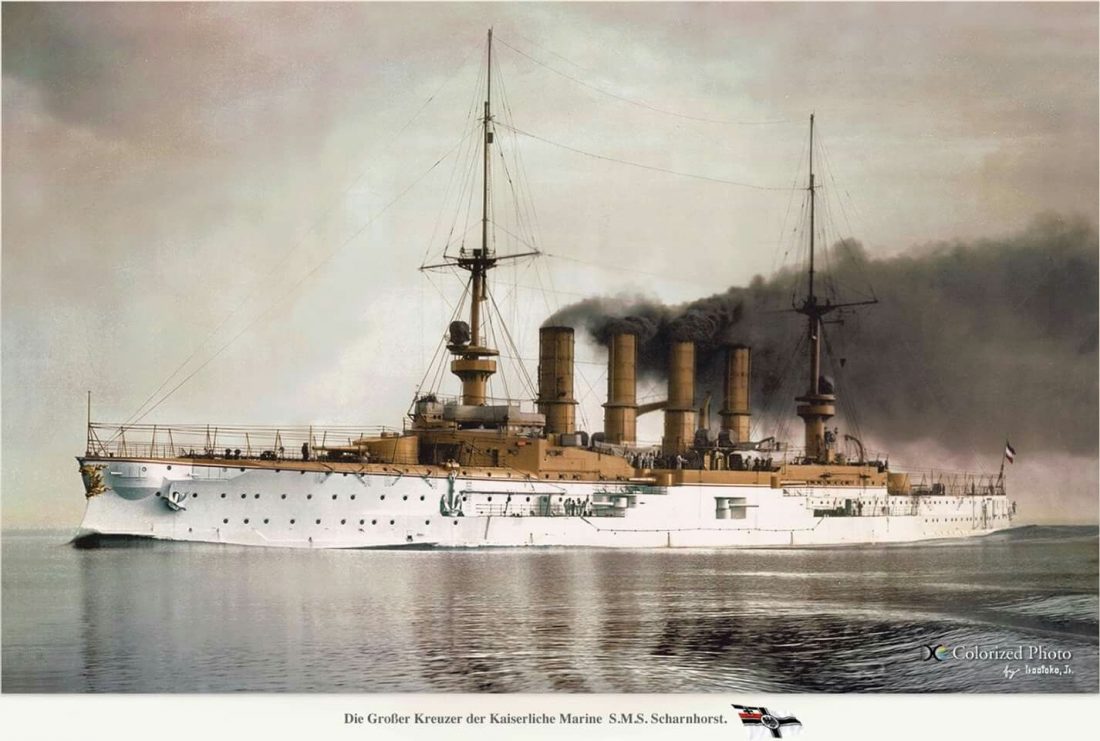
SMS Scharnhorst in peacetime – (Attribution unknown – found on Pinterest)
By contrast, von Spee’s armoured cruisers Scharnhorst and Gneisenau each carried four 8.2-inch weapons in double-gun turrets and each ship’s six 5.9-inch weapons, though casemate-mounted, were higher above the waterline than on the British ships. The German 8.2-inch weapons were markedly superior as regards range and firepower and both vessels had proved themselves as “crack gunnery ships” in peacetime firing exercises. Add to this the superior German armouring and Cradock’s force can be seen to have been wholly outmatched. Though the light cruiser Glasgow was a superb new vessel, and individually superior to any one of her German counterparts, she was outnumbered by Dresden, Leipzig and Nürnberg.
The weakness of Cradock’s force was recognised, but the Admiralty seems to have placed excessive trust in the presence of the Canopus and the four 12-inch guns of her main armament. Cradock was told to use Canopus as “a citadel around which all our cruisers in those waters could find absolute security”.

Cradock
It is notable that both Cradock and von Spee were largely similar personalities – decent and honourable men who shared the same enthusiasm and dedication to their profession and who would have been good friends in other circumstances. There was a chivalry and delicacy about both of them that belonged to an age which had even by then almost disappeared. The Royal Navy was Cradock’s whole life – he never married – and he had said that his preferred death would be either in a hunting accident or during action at sea. A quote from book he wrote in 1908, “Whispers from the Fleet,” describes the operations of a cruiser squadron in near-poetic terms and prefigures, uncannily, the actual death which was to be so close to that he wished for:
“The Scene: – A heaving unsettled sea, and away over to the western horizon an angry yellow sun is setting clearly below a forbidding bank of the blackest of wind-charged clouds. In the centre of the picture lies an immense solitary cruiser with a flag – ‘tis the cruiser recall – at her masthead blowing out broad and clear from the first rude kiss given by the fast rising breeze. Then away, from half the points of the compass, are seen the swift ships of a cruiser squadron all drawing into join their flagship: some are close, others far distant and hull down, with nothing but their fitful smoke against the fast fading lighted sky to mark their whereabouts; but like wild ducks at evening flighting home to some well-known spot, so are they, with one desire, hurrying back at the behest of their mother-ship to gather around her for the night.”
In late October both the British and German forces were close to the coast of Chile, von Spee off Valparaíso and Cradock further south, but no contact had yet been made.
And there we’ll leave them for now, and in a blog next week we’ll learn of the tragic encounter that lay ahead.
Start the Dawlish Chronicles series with the chronologically earliest novel: Britannia’s Innocent
Typical Review, named “The most thoughtful Naval adventure series, ever.”
“Each of the Dawlish Chronicles is better than the last. Combines the action and adventure of Tom Clancy or Bernard Cornwell, with the sensibility of Henry James or Jack London. The hero perseveres in the face of adversity and remains true to his principles and evolving moral sensibilities: becoming more complete with each challenge. Not jingoistic, but a determined ethical man, who will fulfill his duty to the ends of the earth. I can’t wait for the next novel in this series! Thank you Mr Vanner for this fabulous hero placed so aptly into a backdrop of eminent Victorians.”
For more details, click below:
For amazon.com For amazon.co.uk For amazon.com.au
The Dawlish Chronicles – now up to eleven volumes, and counting …
Six free short-stories are available for download to your Kindle or iPhone. Access them by registering for the Dawlish Chronicles mailing list – just click on the banner below. You’ll be kept updated on new books and it facilitates e-mail contact between Antoine Vanner and his readers.


